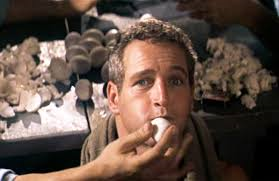Bonnie og Clyde
One of the
classical themes in American movies is the criminal couple who roam the country
stealing and shooting left and right. “Natural Born Killers” and “Thelma and
Louise” are some of the famous examples, but the mother of this sub-genre is “Bonnie
and Clyde”.
Coming out
in 1967, “Bonnie and Clyde” was on the crest of the wave changing American
movies in those years. Heavily inspired by the French New Wave and exploiting
the dissolvement of the Hays code, director and producer were free to make a
wilder version of this story than would have been possible just a few years
earlier. The editing is very modern, there are sexual references that for its
time was surprisingly frank and the violence was brutal and visual in a way
that would have surprised audience in the day, though to a modern viewer perhaps
not so much. However, the theme and the progression of the story, meandering as
it is, are probably the major news from this movie.
Bonnie
(Faye Dunaway) and Clyde (Warren Beatty) meet up in the opening of the movie in
a love-at-first-sight moment. Bonnie is bored and need to get away and Clyde is
charming as hell. That he openly declares that he robs banks seems only to be a
plus. Off they go to rob some banks. On their way they pick up driver and
mechanic C.W. (Michael J. Pollard) and later on Clyde’s brother Buck (Gene
Hackman) and his wife Blanche (Estelle Parsons), making a Barrow gang of five
members. While the guns and a few shots were always part of their modus
operandi, things become more serious when people start dying from their
shooting, especially policemen.
Most of the
movie is the gang constantly shooting their way out of the traps laid by the
police and to the credit of the movie none of that shooting is presented as
particularly glamorous. On the contrary, it is frighteningly real. People die
painful deaths or are wounded in horrible ways. Yet, “Bonnie and Clyde” also
dabbles in the comedic genre with silly scenes and bantering or serious scenes
that becomes involuntarily comic, such as robbing a bank that is already
bankrupt, or having sandwiches with the owners of the car they have just stolen.
I am not as confused by these changes in style and theme as it may appear, this
is after all almost a trope by now, but it is jarring in another way.
My problem
with “Bonnie and Clyde” is the theme itself. This sub-genre has never held any
appeal to me and I cannot get my head around the fascination there seems to be
with outlaw couples shooting their way through the land. I get that there is
something about ultimate freedom and anarchy and also an anti-authoritarian element,
but this is not Robin Hood fighting a cause, but simple criminals. That Clyde
is charming and Bonnie is pretty does not really change that. Getting to know
them does not make me sympathize with them, they only get pity from me,
something they seem incapable of toward their victims. In that sense, the lighter
tones of the movie feel almost insulting. When they die is a hail of gunfire I
am not as much horrified as sighing in relief that it is ended. As you may have
guessed I never seek out this type of movie if I can avoid it.
Having said
that there is no denying the production value in “Bonnie and Clyde”. Everything
technical is top notch. The pictures are gorgeous and knife sharp and makes me
appreciate the Blue-ray format. Acting performances all round are great. All
six main actors were nominated for the Academy award and Estelle Parsons won in
her category. But as mentioned above, the novelties in storytelling that this
movie introduced to American cinema is probably the greatest achievement of the
movie. You watch this movie and it does not look 52 years old.
I was
surprised to find how many actors got their breakthrough with this movie. Faye
Dunaway, Gene Hagman and Gene Wilder were practically new to cinema and went on
to become some of the greatest names.
Only Warren Beatty was an established actor at the time but rather than
being a vehicle for him, “Bonnie and Clyde” is an ensemble movie that let all
of them stand out. It is not often that five actors get nominated from the same
movie.
For those
who are into this genre this is a must-see. For us few who are not, we can at
least enjoy the technical achievements of “Bonnie and Clyde”.




